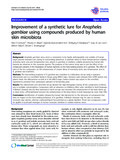Improvement of a synthetic lure for Anopheles gambiae using compounds produced by human skin microbiota

Date
2011-02-08Author
Verhulst, N O
Mbadi, P A
Kiss, G B
Mukabana, W R
van Loon, J J A
Takken, W
Smallegange, R C
Type
Journal ArticleMetadata
Show full item recordAbstract
Abstract
Background
Anopheles gambiae sensu stricto is considered to be highly anthropophilic and volatiles of human origin provide essential cues during its host-seeking behaviour. A synthetic blend of three human-derived volatiles, ammonia, lactic acid and tetradecanoic acid, attracts A. gambiae. In addition, volatiles produced by human skin bacteria are attractive to this mosquito species. The purpose of the current study was to test the effect of ten compounds present in the headspace of human bacteria on the host-seeking process of A. gambiae. The effect of each of the ten compounds on the attractiveness of a basic blend of ammonia, lactic and tetradecanoic acid to A. gambiae was examined.
Methods
The host-seeking response of A. gambiae was evaluated in a laboratory set-up using a dual-port olfactometer and in a semi-field facility in Kenya using MM-X traps. Odorants were released from LDPE sachets and placed inside the olfactometer as well as in the MM-X traps. Carbon dioxide was added in the semi-field experiments, provided from pressurized cylinders or fermenting yeast.
Results
The olfactometer and semi-field set-up allowed for high-throughput testing of the compounds in blends and in multiple concentrations. Compounds with an attractive or inhibitory effect were identified in both bioassays. 3-Methyl-1-butanol was the best attractant in both set-ups and increased the attractiveness of the basic blend up to three times. 2-Phenylethanol reduced the attractiveness of the basic blend in both bioassays by more than 50%.
Conclusions
Identification of volatiles released by human skin bacteria led to the discovery of compounds that have an impact on the host-seeking behaviour of A. gambiae. 3-Methyl-1-butanol may be used to increase mosquito trap catches, whereas 2-phenylethanol has potential as a spatial repellent. These two compounds could be applied in push-pull strategies to reduce mosquito numbers in malaria endemic areas.
URI
http://dx.doi.org/10.1186/1475-2875-10-28http://erepository.uonbi.ac.ke:8080/xmlui/handle/123456789/14717
http://www.ncbi.nlm.nih.gov/pubmed/21303496
